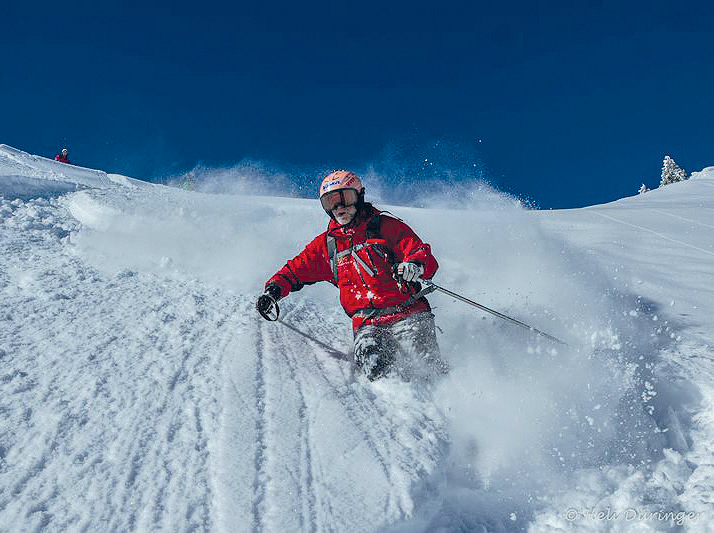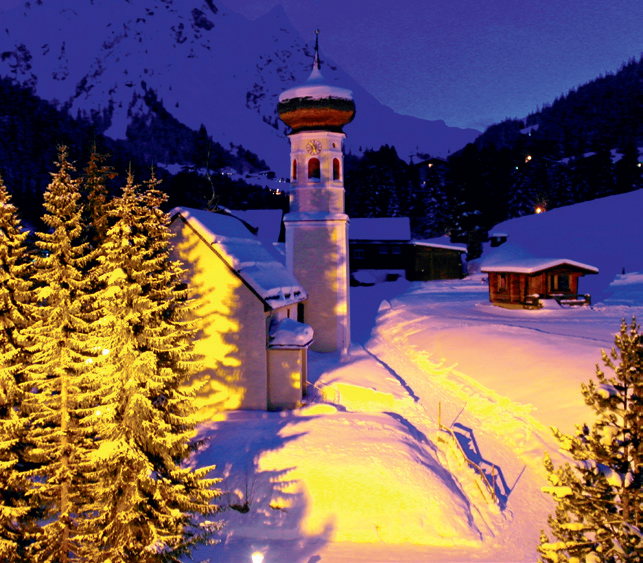A week in the snow, Plenty of nature experiences, deep snow enjoyment garnished with manageable doses of exertion. This can be summed up after the last turn, which was celebrated in Montafon at the Gargellen valley station with a hot Jagatee. Because an Austrian federal state cannot be so small that crossing it on skis would not involve a touch of exertion. The crossing of Vorarlberg from Kleinwalsertal to the rear of Montafon is not an extreme tour in the comfort version of Ski Ride Vorarlberg: Rather, it is a luxury example, costing just under 3,000 euros depending on the number of people, of how the touring and freeride boom in our home region can be optimally prepared for people who would otherwise go heli-skiing in the Canadian Rockies. It takes place by individual appointment for groups of a maximum of six people. In addition to overnight stays and accompaniment by experienced guides, lift tickets, transfers and luggage transport are included. Accommodation is in fine houses, the ascents become mostly driveways, while the descent is temptingly deep snow. If there is anything extreme, it is pleasure.
Of course, with such a bright blue sky, enthusiasm only needs a little encouragement. In order to get started right away in the morning, the minibus takes the adventurous skiers to Kleinwalsertal after meeting in Dornbirn. The Chesa Valisa in Hirschegg guarantees the first two nights of solid comfort. The first day of skiing, on the other hand, is for getting to know each other. The colleagues, the guides, the equipment and your own abilities. At the "local tip" Walmendinger Horn, a certain level of over-motivation is guaranteed from the start. The best touring equipment with a focus on downhill skiing was set up the day before. In other words, what is needed is not ultra-light skis for mountaineers, but rather skis that are as optimal as possible for pistes and deep snow sections and not too heavy.
First you go up from Mittelberg, then over the pistes with few people, especially in the area of the Muttelberg 4-seater chairlift. At the mountain station you put on your skins and then over the sometimes slightly nerve-racking ridge to the Muttelbergkopf to experience a sensational, untracked and quite challenging descent through the powder (yes, you can say powder when you say powder!). Simply a great line! So it became clear on the first day: no one needs to travel to Canada for heli-skiing. The so-called "Ski Ride Vorarlberg" is enough.

Sometimes powder falls from the sky. You just have to accept that sometimes. Even if the sun peeked through several times on the trip from Hirschegg up to the Ifen valley station. Soon we put on our skins and conquer the Hahnenköpfle (2,085 m). It feels like a North Pole expedition with heavy snowfall and wind. The crossing over the Gottesacker, which is peppered with limestone holes - a name that says it all - is a sensational nature experience in sunshine. In fog, however, it is a nature adventure that demands all the concentration from the guides and no less trust from their charges. In addition to the experience at the Gottesacker, the GPS also helps to find the right entry into the Kalbelegüntles. It is the end of the crossing and the start of the descent to the Schönenbachalm.
The night and the day, which was already over eleven hours old, have brought more snow than expected. Carefully – and one at a time! – we head up the 33-degree slope, feeling our way, before the visibility and the snow allow us to make a series of brilliant deep snow turns. It gets tight again at the slip, which is a few degrees steeper but shorter and represents the last, pleasurable hurdle before the alpine world below the Ifen. From there, we glide gently until, after a small counter-climb, we reach the snow-covered Schönenbach pasture. It is already 2 p.m. and the hunger we have suppressed until then is breaking out. The next day we head into absolute skiing civilization. The Arlberg is waiting and if it is a picture-perfect day, then it is far too beautiful to concentrate on photos.
Enjoyable – even if with this amount of snow, the fun can sometimes turn into work in terms of fitness. While the guides were "tracking" in the terrain the day before, the team manager got us to make tracks ourselves.
At 8:05 a.m. we took the ski bus from Schoppernau to Warth. We were ready to go before the lifts even started, and after a short ascent and descent we finally crossed into the Lech area. The rest was a dream in white, deep snow slopes challenging and fun, and powder up to the tip of your nose. To be honest - it's impossible to name the individual slopes we skied on. Because of the snowfall, it was important not to go too far into the terrain and in the morning even on the Arlberg not everything was tracked. And that's saying something.
The brilliant weather stayed with us until the Edelrast in Hirlanda, then a storm came up. It was no longer advisable to complete the White Ring via Zug. The Madloch was also soon closed. But our replacement is not wrongly considered one of the best runs on the Vorarlberg side of the Arlberg: the entrance to the high alpine "Wiesele" is to the right of the Madloch valley station. After several slopes with only short crossings you end up at the gallery between Lech and Zürs. The ski bus takes you back to a night of luxury.

Bocksäcklru is how the Bregenzerwalder describes the weather that awaits us the next day. In phonetic spelling. Thick flakes, wind. But we set off punctually at 9 a.m. down to the Rüfikopf cable car. At the top there is no choice, only one piste open towards Zürs, but the situation soon improves. The otherwise possible tour variant over the Trittkopf and over the gallery to Stuben obviously doesn't work with such a risk of avalanches. The bus to Alpe Rauz remains, where we briefly touch Tyrolean soil with the Valfagehr cable car. From there we go down to Stuben quickly over the wide piste, then continue with the post bus to Klösterle to the Sonnenkopf. The snowfall has lightened, opening up a panorama of untouched deep snow slopes. We quickly clear the virgin state in places. After a lunch break in the glass Muttjöchle hut, the climb to the Muttjöchle (2,076 m) follows. The flat afternoon sunlight leads to a photo frenzy - and it gets later. After the summit photo, the tour descent also turned out to be sweaty. A few turns in the snow, which was probably around a meter deep here, were followed by flat hiking trails. At some point the small Kristberg ski area appears. Skiing had long since ended here when we were winding down the last ski route into the Silbertal near Schruns.

Silvretta Nova as a great finale. This is what awaited us on the sixth day, which starts with the ascent with the Hochjochbahn. At the top, you can join a powder program almost every day, on Fridays, for example, the Zamangspitze summit assault. The ascent over the exposed ridge to the Zamangspitze is no mean feat. But what follows is the longest variant descent of 1,500 meters in altitude! And not just any variant, but perfect, especially in the upper section. However, for descents of this length, apart from really cold powder snow days in mid-winter, you have to expect varying snow quality. We took more than just a few minutes up there to get the conditions optimal - and with wide turns in the upper section, the plan worked out perfectly. If you go down to St. Gallenkirch, you can board the Valisera cable car again above the road to pay a visit to the endless Silvretta Nova ski area. It's a short one, because the last highlight at the top is one of the touring descents towards Gargellen. At first it's a test of courage, because we choose a notch that we cross with a rope. But then it's a fantastic tour. Later on in Gargellen, spectacular slopes await us, such as Nidla, Rinderhütte, Täli and of course the Madrisa steep slope. Even when there is a risk of avalanches, there are always spectacular deep snow sections close to the piste - especially in the forest area - that are fun to behold.